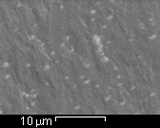The initial situation
Polyimide / PI (e.g. Kapton ®) is an advantageous substrate material for flexible printed boards, ribbon cables and multilayer PCBs because it combines mechanical strength, temperature and chemical stability with good dielectric properties. For these reasons, PI has become increasingly widely used in recent years, especially in miniature devices such as mobile phones, in automobile electronics, aerospace electronics etc..
High demands are placed on the reliability of PCBs used in these applications, many of them being safety related. In particular, the copper conductors must adhere firmly to the polyimide to withstand the thermoshock from the soldering during the PCB assembly as well as the stresses from the vibrations, shocks, temperature and humidity fluctuations during the device exploitation.
Currently, copper-polyimide laminates are made almost exclusively by adhesive bonding. The tendency towards using ever thinner PCBs means however that the adhesive makes up an ever higher proportion of the overall mass of the PCBs, which results in worsening of the electrical and mechanical properties of the system. Other methods of manufacturing copper-polyimide laminates are therefore becoming increasingly interesting.
One technology that is particularly suitable for making thin laminates is the vacuum deposition (PVD) of a thin (a few hundred nm) copper layer, followed by galvanic reinforcement. Using a semi-additive method, only the conductors are galvanically reinforced, leading to both economic and technical advantages (improved resolution). Previously, sufficient adhesion could only be achieved by using a chromium PVD intermediate layer. This technology was not widely accepted by the industry, as the chromium layer requires an additional etching process during the PCB production.
 Fraunhofer Institute for Interfacial Engineering and Biotechnology IGB
Fraunhofer Institute for Interfacial Engineering and Biotechnology IGB
